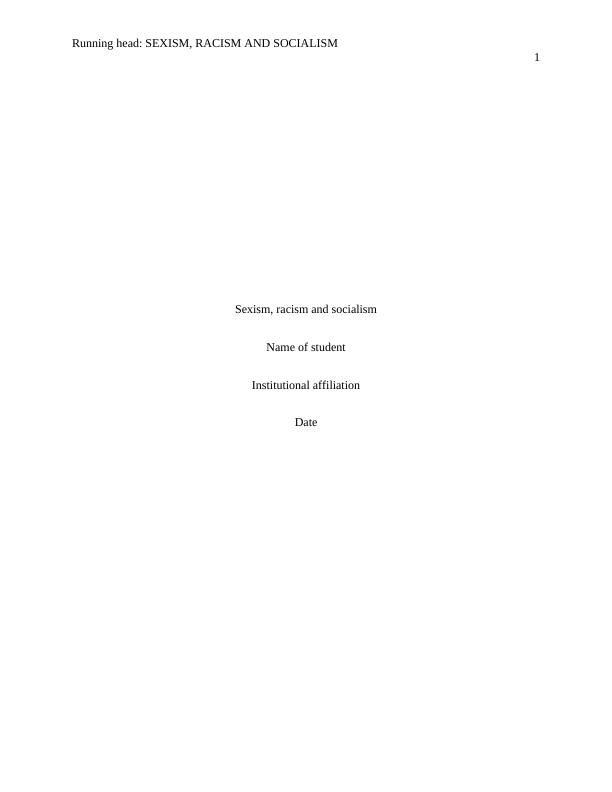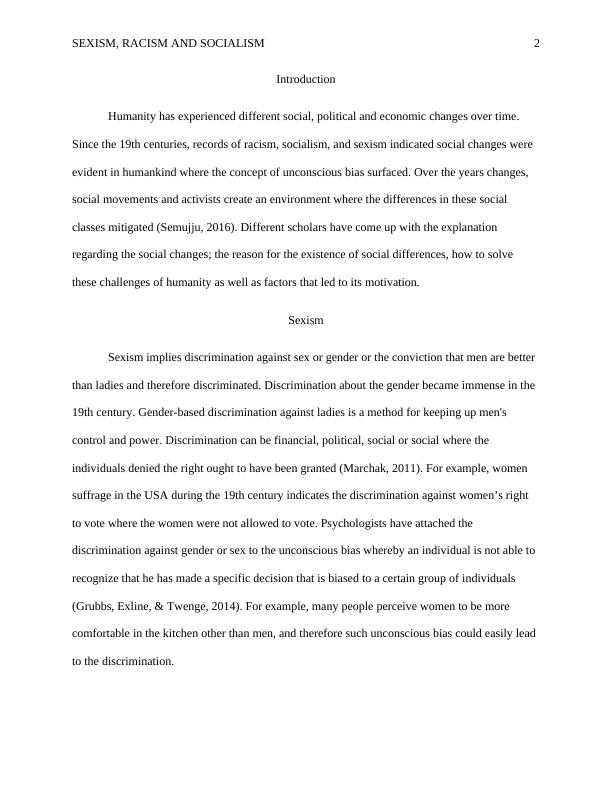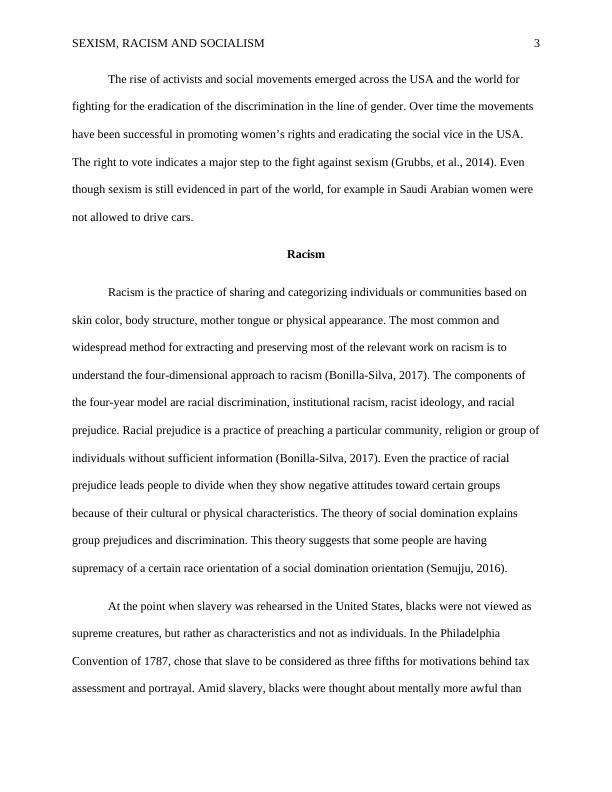Sexism, Racism and Socialism: Understanding the Social Changes
8 Pages1818 Words377 Views
Added on 2023-06-04
About This Document
This article discusses the concepts of sexism, racism and socialism, their impact on society, and how social movements have fought against them. It also explores the connection between racism and capitalism.
Sexism, Racism and Socialism: Understanding the Social Changes
Added on 2023-06-04
ShareRelated Documents
Running head: SEXISM, RACISM AND SOCIALISM
1
Sexism, racism and socialism
Name of student
Institutional affiliation
Date
1
Sexism, racism and socialism
Name of student
Institutional affiliation
Date

SEXISM, RACISM AND SOCIALISM 2
Introduction
Humanity has experienced different social, political and economic changes over time.
Since the 19th centuries, records of racism, socialism, and sexism indicated social changes were
evident in humankind where the concept of unconscious bias surfaced. Over the years changes,
social movements and activists create an environment where the differences in these social
classes mitigated (Semujju, 2016). Different scholars have come up with the explanation
regarding the social changes; the reason for the existence of social differences, how to solve
these challenges of humanity as well as factors that led to its motivation.
Sexism
Sexism implies discrimination against sex or gender or the conviction that men are better
than ladies and therefore discriminated. Discrimination about the gender became immense in the
19th century. Gender-based discrimination against ladies is a method for keeping up men's
control and power. Discrimination can be financial, political, social or social where the
individuals denied the right ought to have been granted (Marchak, 2011). For example, women
suffrage in the USA during the 19th century indicates the discrimination against women’s right
to vote where the women were not allowed to vote. Psychologists have attached the
discrimination against gender or sex to the unconscious bias whereby an individual is not able to
recognize that he has made a specific decision that is biased to a certain group of individuals
(Grubbs, Exline, & Twenge, 2014). For example, many people perceive women to be more
comfortable in the kitchen other than men, and therefore such unconscious bias could easily lead
to the discrimination.
Introduction
Humanity has experienced different social, political and economic changes over time.
Since the 19th centuries, records of racism, socialism, and sexism indicated social changes were
evident in humankind where the concept of unconscious bias surfaced. Over the years changes,
social movements and activists create an environment where the differences in these social
classes mitigated (Semujju, 2016). Different scholars have come up with the explanation
regarding the social changes; the reason for the existence of social differences, how to solve
these challenges of humanity as well as factors that led to its motivation.
Sexism
Sexism implies discrimination against sex or gender or the conviction that men are better
than ladies and therefore discriminated. Discrimination about the gender became immense in the
19th century. Gender-based discrimination against ladies is a method for keeping up men's
control and power. Discrimination can be financial, political, social or social where the
individuals denied the right ought to have been granted (Marchak, 2011). For example, women
suffrage in the USA during the 19th century indicates the discrimination against women’s right
to vote where the women were not allowed to vote. Psychologists have attached the
discrimination against gender or sex to the unconscious bias whereby an individual is not able to
recognize that he has made a specific decision that is biased to a certain group of individuals
(Grubbs, Exline, & Twenge, 2014). For example, many people perceive women to be more
comfortable in the kitchen other than men, and therefore such unconscious bias could easily lead
to the discrimination.

SEXISM, RACISM AND SOCIALISM 3
The rise of activists and social movements emerged across the USA and the world for
fighting for the eradication of the discrimination in the line of gender. Over time the movements
have been successful in promoting women’s rights and eradicating the social vice in the USA.
The right to vote indicates a major step to the fight against sexism (Grubbs, et al., 2014). Even
though sexism is still evidenced in part of the world, for example in Saudi Arabian women were
not allowed to drive cars.
Racism
Racism is the practice of sharing and categorizing individuals or communities based on
skin color, body structure, mother tongue or physical appearance. The most common and
widespread method for extracting and preserving most of the relevant work on racism is to
understand the four-dimensional approach to racism (Bonilla-Silva, 2017). The components of
the four-year model are racial discrimination, institutional racism, racist ideology, and racial
prejudice. Racial prejudice is a practice of preaching a particular community, religion or group of
individuals without sufficient information (Bonilla-Silva, 2017). Even the practice of racial
prejudice leads people to divide when they show negative attitudes toward certain groups
because of their cultural or physical characteristics. The theory of social domination explains
group prejudices and discrimination. This theory suggests that some people are having
supremacy of a certain race orientation of a social domination orientation (Semujju, 2016).
At the point when slavery was rehearsed in the United States, blacks were not viewed as
supreme creatures, but rather as characteristics and not as individuals. In the Philadelphia
Convention of 1787, chose that slave to be considered as three fifths for motivations behind tax
assessment and portrayal. Amid slavery, blacks were thought about mentally more awful than
The rise of activists and social movements emerged across the USA and the world for
fighting for the eradication of the discrimination in the line of gender. Over time the movements
have been successful in promoting women’s rights and eradicating the social vice in the USA.
The right to vote indicates a major step to the fight against sexism (Grubbs, et al., 2014). Even
though sexism is still evidenced in part of the world, for example in Saudi Arabian women were
not allowed to drive cars.
Racism
Racism is the practice of sharing and categorizing individuals or communities based on
skin color, body structure, mother tongue or physical appearance. The most common and
widespread method for extracting and preserving most of the relevant work on racism is to
understand the four-dimensional approach to racism (Bonilla-Silva, 2017). The components of
the four-year model are racial discrimination, institutional racism, racist ideology, and racial
prejudice. Racial prejudice is a practice of preaching a particular community, religion or group of
individuals without sufficient information (Bonilla-Silva, 2017). Even the practice of racial
prejudice leads people to divide when they show negative attitudes toward certain groups
because of their cultural or physical characteristics. The theory of social domination explains
group prejudices and discrimination. This theory suggests that some people are having
supremacy of a certain race orientation of a social domination orientation (Semujju, 2016).
At the point when slavery was rehearsed in the United States, blacks were not viewed as
supreme creatures, but rather as characteristics and not as individuals. In the Philadelphia
Convention of 1787, chose that slave to be considered as three fifths for motivations behind tax
assessment and portrayal. Amid slavery, blacks were thought about mentally more awful than

End of preview
Want to access all the pages? Upload your documents or become a member.
Related Documents
Women Studies - Assignmentlg...
|5
|1216
|14
